The PHZ-89, also known as Type 89, is today the main Chinese PLA armoured tracked multiple launch rocket system (MLRS). It was developed by NORINCO in the 1980s to procure a first line quick artillery support organic to armoured divisions and offering better protection than vehicles such as the BM-21 Grad. Main contractor for the project was China North Industries Group Corporation (CNGC), now NORINCO. Development and production was carried out by Harbin First Machinery Factory (674 Factory) and Hubei Jiangshan Machinery Factory (5137 Factory). It was replacing the Type 70 130mm, 19-tube self-propelled MRL. It is here placed in the cold war section, despite the fact it was in service by 1990, because its development took place years before. Fully armoured, tracked to be used on all terrains, it is better suited for the needs of the army in campaign than the previous softskin rocket launcher trucks usually used in this role.
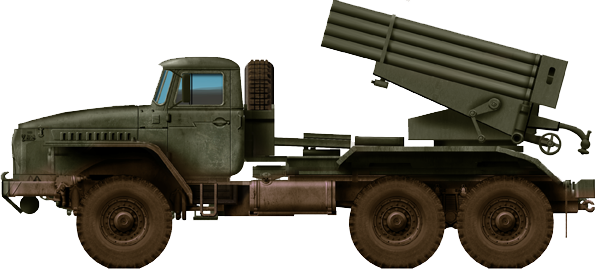
Russian BM-21 "Grad"
The rocket launcher itef is aingle tube assembly close to the BM-21 system, and placed at the rear on a traversing mount/rotating cradle assembly offering 208° of traverse (104 left and right). There is a a large reloading rack mounted at the front of the tracked Type 321 utility chassis, behind the glacis front. The launcher is electrically powered, comprising four rows of 10 tubes each mounted above each others. The launch tubes have an elevation range of 0°-55°, azimuth range -102° to +66°. There is an electrical firing system enable single rocker or volley fire with each rocker launched by separared by 0.5 seconds interval. In total, all 40 can be fired using the continuous shooting mode. The system was tested to fire 40 rockets in 20 seconds while the reloading process took about 3 minutes, including the aiming to target of the reloaded launcher.
Firing accuracy is provided by a fire-control assisted by a computerised, managing target information from the command vehicle, or though manual input. Its calculating ballistic trajectories given sensory consitions of wind, moist and heat, adjusting the elevation and traverse to the own vehicle inclination on the ground and and gradient.
Development
In the early 1980s, the 674 Factory and 5137 Factory were contracted to develop together a self-propelled MRL for the standard 122mm rocket, a tracked chassis. It was initially intended for export and after reaching an advanced design stage in 1985, it was mothballed due to to lack of interest on the international market. The PLA was interested however, and in 1986 it was marked to be the next-generation artillery rocket system organic to its divisions. It was not reaily available through. The PLA indeed, issued many requirements to improve it: Automated launching and reloading operations, and the addition of a defensive 12.7mm anti-aircraft machine gun. It was also established it needed to have its noise reduced, and protect its crew with a collective NBC lining and overpressure system. The prototype of the future Type 89 rolled out in February 1987 and mobility testing started. It went on between March and November 1987. New weapon tests were carried out in 1988, including in operational unit, added to endurance tests by allweathers and on all terrains. In total the prototypes travelle over 30,000 km and fired a total of 707 rounds. In February 1989 at last, it was approved by the State Council and Central Military Commission, and greenlighted for production. Its first designation was Type 89 but it was later changed under the new nomenclature as PHZ89.
Russian BM-21 "Grad"
Design
The rocket launcher of the Type 89 was developed from the Type 81 122mm MRL system. It was a Chinese copy of the Russian BM-21 ‘Grad’. The Type 321 utility tracked chassis was chosen as a basis to mount it, and it was itself developed from the Type 83, 152 mm self-propelled gun-howitzer. In total the vehicle, which was lightly protected as customary for rear-line combat vehicles, had a combat weight of 30t, and a maximum road speed of 55km/h. It was operated by a crew of five, the driver at the front commander at the left rear, gunner right rear (either side of the rocket mount) and two operators in the hull, tasked of reload and targeting/plotting.Engine and performances
The Type 89 MLRS was originally powered by a WR-4B 520hp liquid-cooled diesel, derived from a Deutz Type 12150L diesel and carried 885 Liters of diesel for a maximal range of 450 km. It had a Ppwer to weight ratio of 17.4 hp/t. Its chassis passed this power onto six unevenly spaced road wheels or torsion bars, with a front drive sprocket and aft idler. The tracks returned on three support rollers. Track width was 0.48 m, length on ground 4.61 m and tread 2.62 m. Mobility performances included a top speed of 55 km/h on road, 40 km/h at cruise speed to spare fuel and 30 km/h cross country. Its Ground clearance was 0.45 m, and it could climb a wall 0.7 m high, cross a trench 2.6 m wide, climb a 60% Gradient and ford 1.3 m unprepared.Armor protection and defensive armament
The type 89 had a limited armour protection: It was made of steel RHA, but only 7 mm on average all around, enough to protect the crew from shrapnell and small arms fire, although artificially thicker at the sloped glacis. Some sources states the frontal protection it offered was enough against heavy machine guns round (14 mm). Sources also diverged on its collective protection. It us supposed to have a centralised NBC-protection system. For active protection, there could be a set of smoke projectors, but there were never shown on photos. The main defensive armament, outside the small arms of the crew, is a 12.7 mm/50 QJC88 heavy machine gun. It was installed on a pintle mount at the rear, in the right superstructure housing the gunner. It provided ground target cover as well as AA cover.Launcher system
The PHZ-89 is equipped with basically the same launcher as the Russian Grad. These 122 mm standard rockets carries a high explosive warhead. These are "free rockets" (no guidance) and their top range which could reach as far as 30km depends on the warhead type. The rocket itself is in one piece, with its warhead attached on the rest of the body comprising the rocket motor and its long booster. It contains a fixed amount of propellant. The rocket is providned with fixed fin and low speed spin stabilisation for accuracy. The standard high-explosive (HE) warhead contains steel balls and/or prefabricated fragments to prove a shrapnell effect. NORINCO has developed specialised warheads available for this rockert depending on the mission, such as the High-Explosive Incendiary (HEI), the anti-tank/anti-personnel submunition (ATP), the minelaying type which lands a mine on the spot.- Rocket length: 2,870mm (20 km range), 2,757mm (30 km range)
- Launch tube length: 3,000 mm
- Rocket weight: 67 kg (with a range of 20 kilometers), 61 kg (with a range of 30 kilometers)
- Warhead weight: 18.3 kg
- Maximum range: 20 km ~ 30 km
- Launch speed: 40 rockets within 20 seconds
- Reload time: 3 minutes
The rocket launcher itef is aingle tube assembly close to the BM-21 system, and placed at the rear on a traversing mount/rotating cradle assembly offering 208° of traverse (104 left and right). There is a a large reloading rack mounted at the front of the tracked Type 321 utility chassis, behind the glacis front. The launcher is electrically powered, comprising four rows of 10 tubes each mounted above each others. The launch tubes have an elevation range of 0°-55°, azimuth range -102° to +66°. There is an electrical firing system enable single rocker or volley fire with each rocker launched by separared by 0.5 seconds interval. In total, all 40 can be fired using the continuous shooting mode. The system was tested to fire 40 rockets in 20 seconds while the reloading process took about 3 minutes, including the aiming to target of the reloaded launcher.
Firing accuracy is provided by a fire-control assisted by a computerised, managing target information from the command vehicle, or though manual input. Its calculating ballistic trajectories given sensory consitions of wind, moist and heat, adjusting the elevation and traverse to the own vehicle inclination on the ground and and gradient.
Service
Since the vehicle was not exported, believed to be too complex for the export market, since its introduction in 1990 it has never been deployed outside China. Although it is comparable to the US M270 MLRS, it fires forty 122 mm rockets at a range of 25-30 km versus at least 32 km for 12 heavier rockets (227 mm) for the M270. So less punch at shorter distance, but more projectiles to the target. Evolved projectiles of the M270 has a far greater range, hitting power and accuracy. This other advantage of the PHZ-89 is a built-in reload system allowing to fire two salvoes in 3 minutes, for a total of 80 rockets. An estimated 400-500 vehicles are in service today, 300 units were deployed as of August 2017.PHZ-89 specifications | |
| Dimensions | 6.85/7.18 m oa x 3.15 m x 3.18 m oa |
| Total weight, battle ready | 29.9 tons |
| Crew | 5 (driver, commander, gunner, 2 operators) |
| Propulsion | Deutz Type 12150L diesel 520 hp, storage 885 L |
| Suspension | Tracked chassis, 6 roadwheels, torsion bars suspensions |
| Speed (road) | 110 km/h (70 mph) |
| Range | 600 km (370 mi) |
| Armament | 90 mm (3.54 in) CATI gun or 60 mm (2.36 in) breech-loaded mortar 2xFN MAG machine-guns |
| Armor | Unknown |
| Total production | 62 in 1971-1972 |
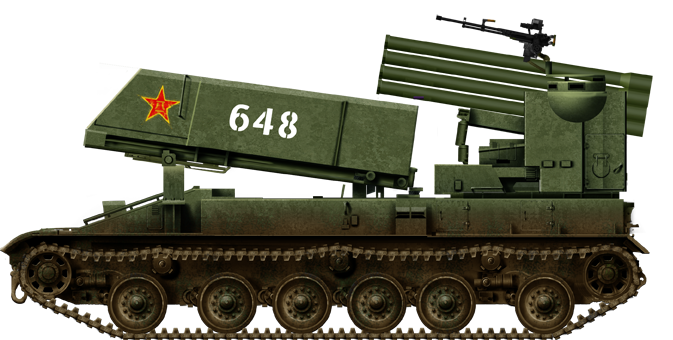
A Type 89 in evaluation in 1989 before acceptation by the PLA.
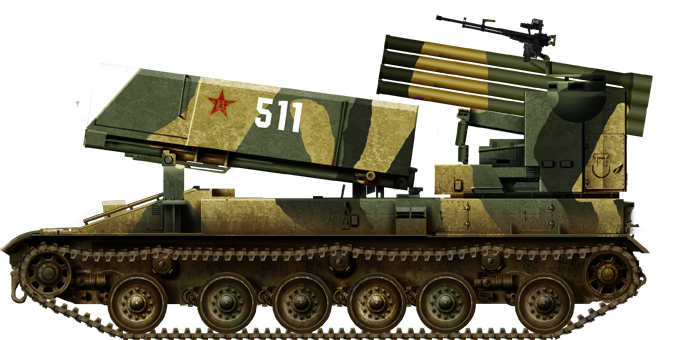
PHZ-89 in service today. No digital camouflage seen yet, but the base tri-tone wavy army pattern.
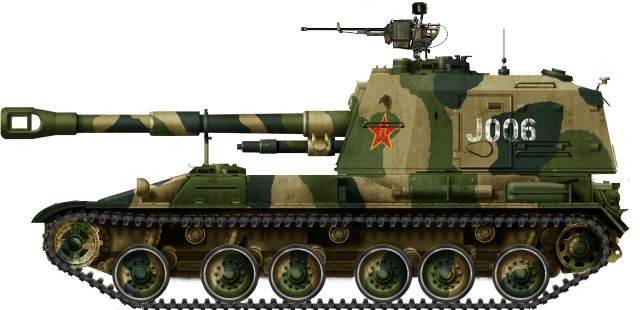
Type 83 SPH, on which the Type 89 SPRL was based
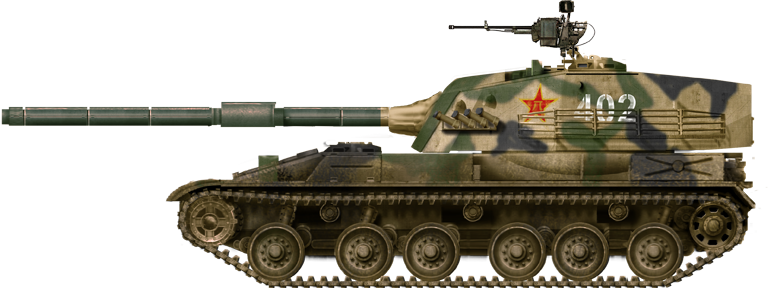
There was another "type 89" based on the same chassis (modified), which was the PZT-89 tank hunter

Another SPH/SPG based on the same chassis, the PLZ-05
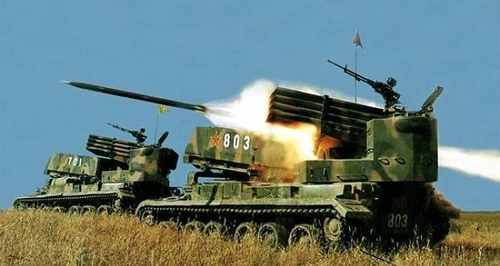
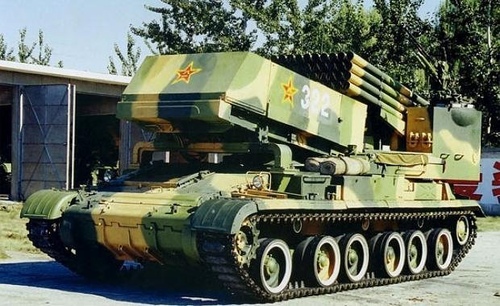
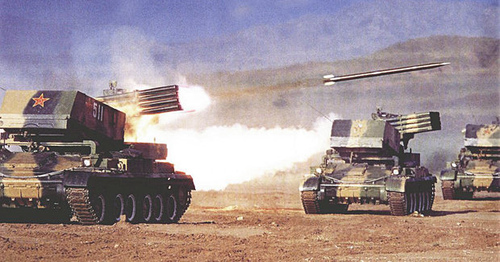
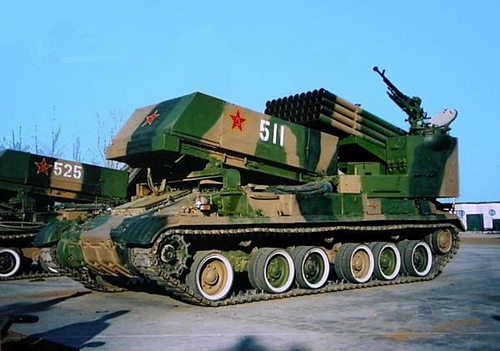
Various photos from the web
Links
On weaponsystems.netOn armyrecognition.com
On army-guide.com
On blog.xuite.net
On deagel.com

Cold War Tanks


































Cold war tanks posters

Cold War Main Battle Tanks

Cold War Soviet Army

